Affiliate disclosure: This post may contain affiliate links. Please see our disclosure policy.
Foraging with kids is a great way to spend time with your little ones outdoors.
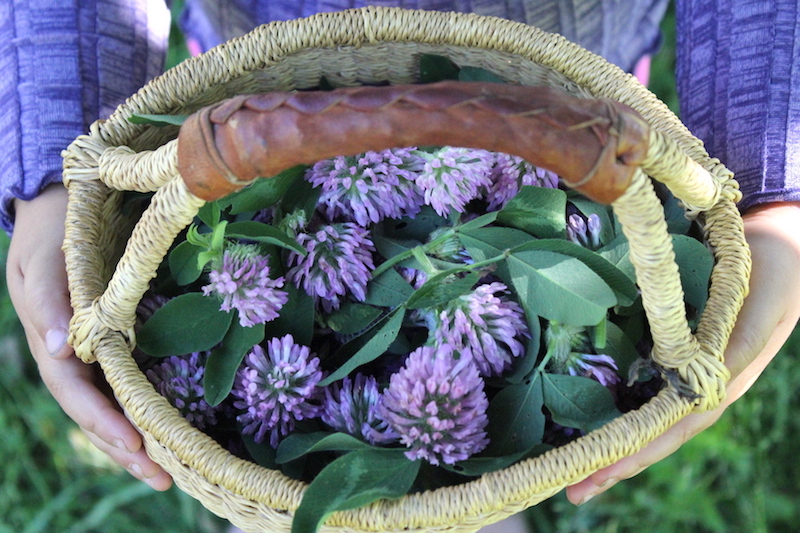
Kids are naturally curious and want to put just about everything into their mouths anyway, why not direct that towards tasty wild food? Foraging helps tap all that curious energy into nature exploration while teaching them valuable skills at the same time.
Getting Started Foraging with Kids
If you’re a beginning forager yourself, start simple.
Edible flowers are a great beginning, and they’re delicious for kids and adults alike. There’s a surprising variety of edible flowers, both wild and cultivated. In many cases, you don’t have to look past grandma’s flower garden to find delicious “wild” edibles to peak a little one’s interest.
In the summertime, foraging is just a natural part of our daily routine.
When my daughter was born that didn’t change, and she began harvesting wild plants with me before she could walk. Little hands are naturally drawn toward bright colorful objects at their level, and I set my baby down in a patch of red clover with a basket.
A bit of guidance and she spent an hour carefully harvesting red clover blossoms and filled her harvest basket.
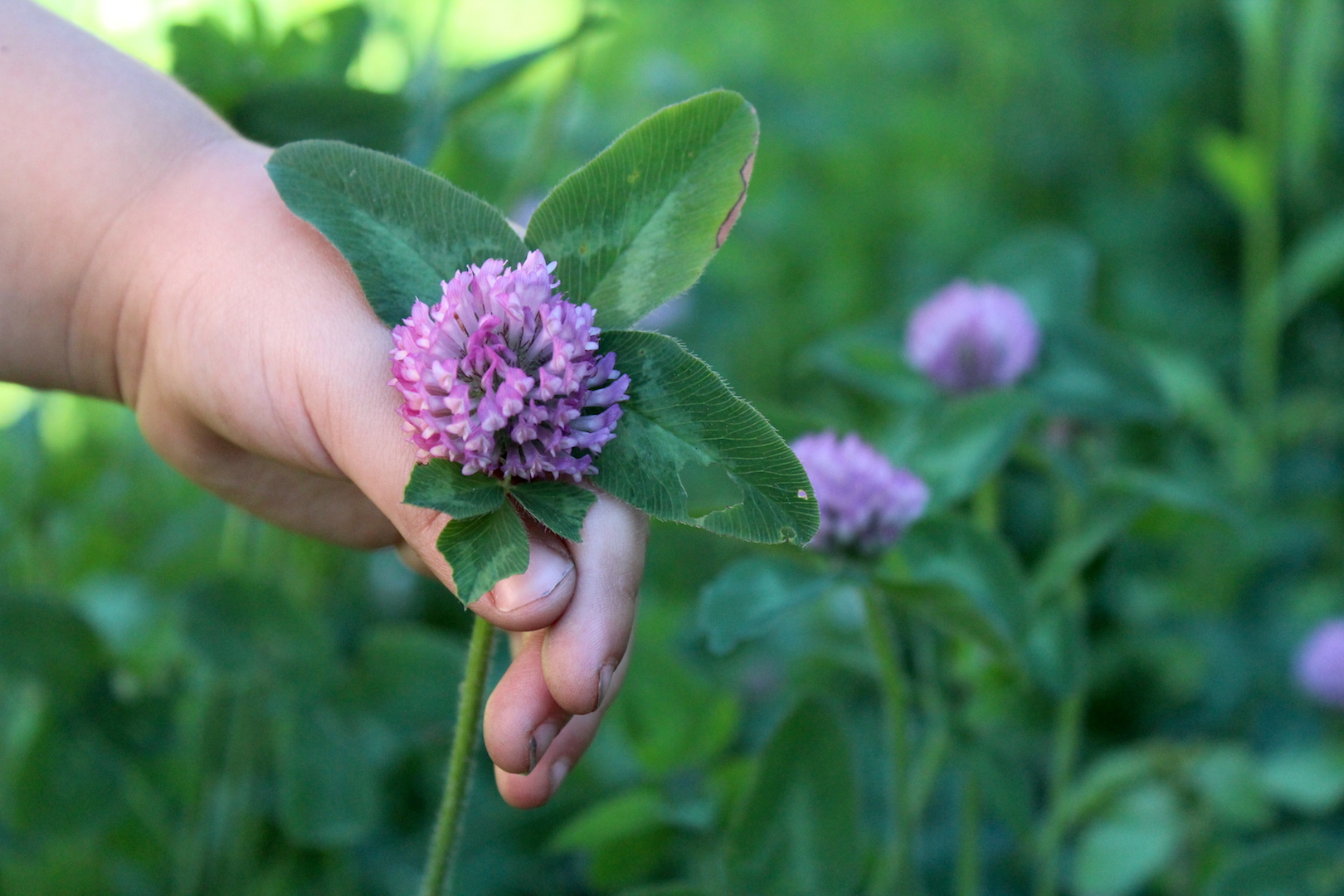
The following summer, the little ones could participate more fully and things got a whole lot more fun.
Add a bit of walking and talking into the mix, and children can actually express how much they love the idea of harvesting their own lunch.
Everywhere we go she’d see flowers and ask, “Is that an eating flower mama?” That’s led to some wonderful interactions with friends and neighbors, especially when they’re in an older generation.
In a neighbors garden, she politely asked if she could eat the bee balm. The neighbor didn’t know that one was edible, and my little one showed her how to enjoy the petals.
The neighbor then took her on a tour of all the wild weeds in her garden that she used to harvest as a child.
She told her stories about harvesting jewelweed seed pods, that pop in your mouth as you eat them and taste like black walnuts. She let us sample her hosta flowers and showed us the best technique for eating daylily blossoms.
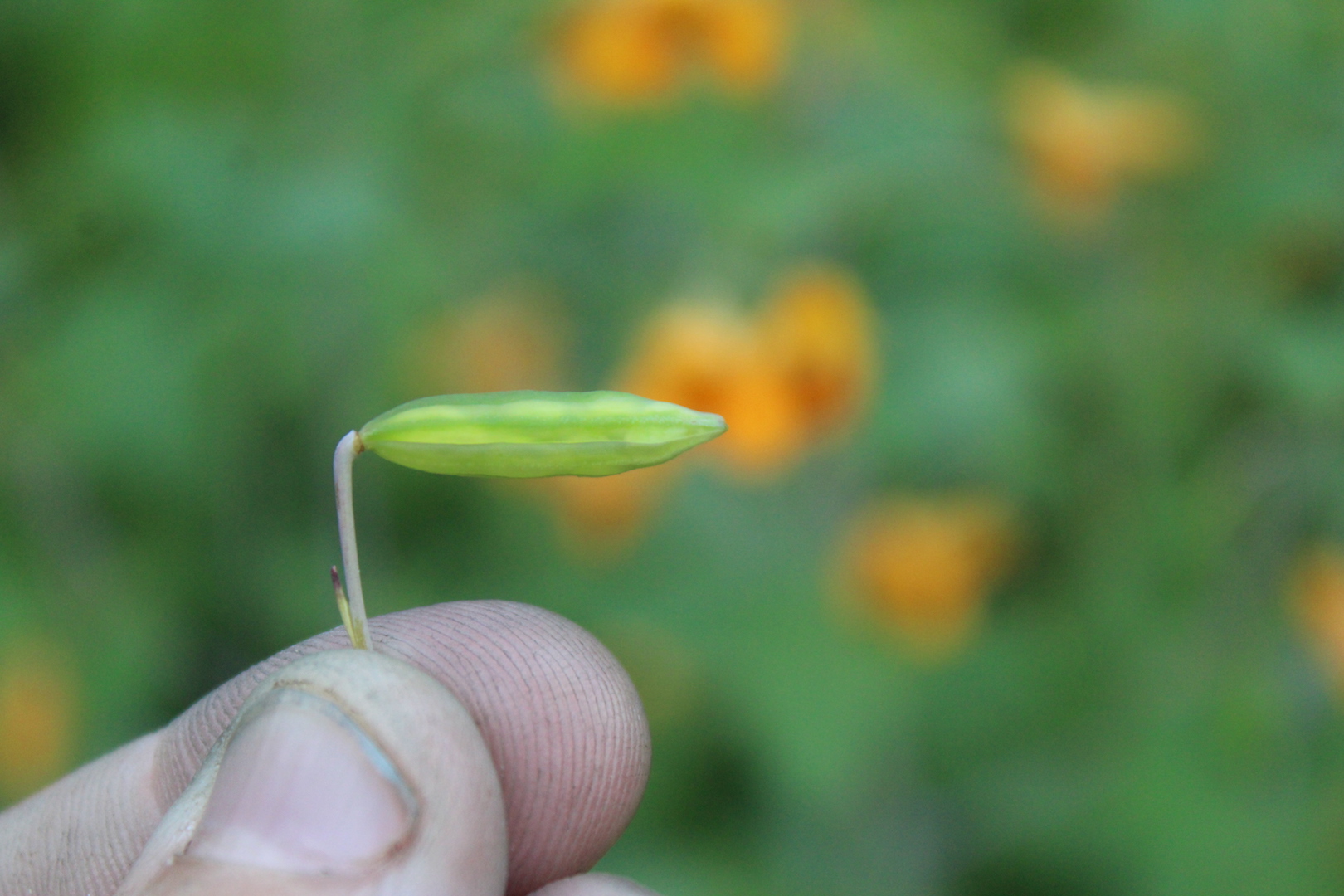
While flowers are an excellent place to start when you’re teaching the youngest foragers, it’s easy to quickly expand to more advanced crops.
Chanterelles began to pop out of the forest soil just after my daughter’s second birthday, and we went into the woods to harvest them together.
Foraging mushrooms with kids takes a bit more discussion, and it’s important to communicate that all mushrooms need to be cooked before you can eat them. Whether or not that’s strictly true is up for debate among mushrooms, but that simple rule allows for every last morsel to be checked over before it goes into a little one’s mouth.
I brought my newborn son in a backpack, and my daughter carried her favorite stuffed animal in a backpack too. I’d pause to teach her something, and she’d settle in to pass the lessons on to her stuffie. Here she is teaching her furry friend the finer points of chanterelle identification.
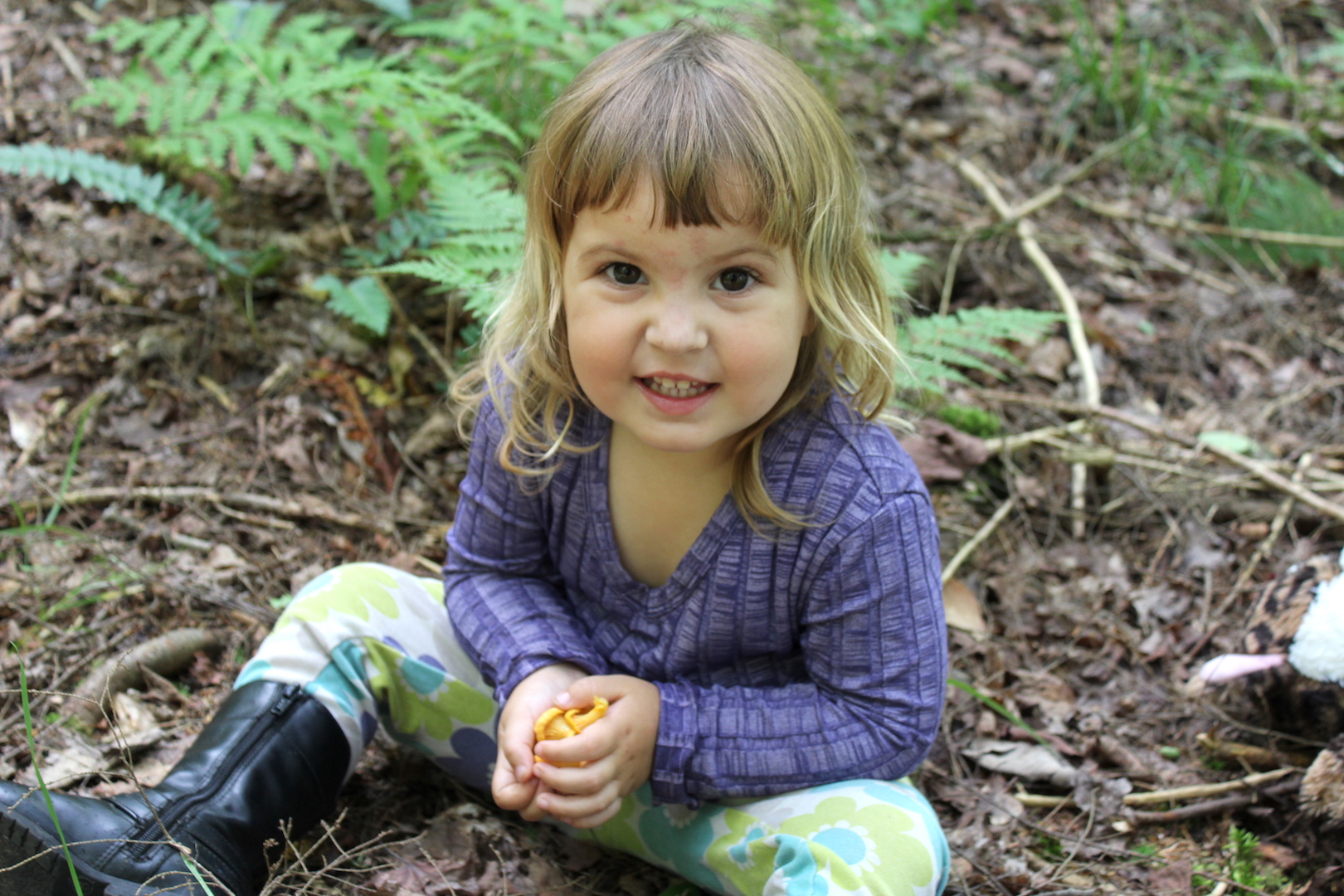
Once you’re ready to start introducing your kids to foraging, here are a few tips to get you started.
Start with Familiar Plants
When I say start with familiar plants, I mean start with plants that are a part of their everyday life.
If there’s a maple tree in the yard, try tapping it for syrup. Look for edible weeds in the lawn, that same lawn they run barefoot over all summer long. Things they see and experience every day will have more meaning than even the most exciting find 10 miles and a car ride away.
Simple things, like dandelion blossoms, can be made into all manner of delicious things with the right dandelion recipes. I make dandelion shortbread, dandelion honey marshmallows, dandelion gummy bears, and dandelion ice cream for my little ones. I even can up dandelion jelly from their harvests, so we eat a taste of sunshine all year round.
If they’ll put the time into picking the blossoms, there will be treats.
See the subtle bribe there? It’s all in the name of getting them outside and excited about nature (and foraging).
If you don’t have a lot in the yard, maybe it’s time to remedy that. Toss a handful of yarrow seeds here and there, or encourage forageable crops by converting a portion of the yard to more “wild” space.
Even if you’re in an apartment, there’s plenty of urban wild edibles to be found in sidewalk cracks and neighborhood parks.
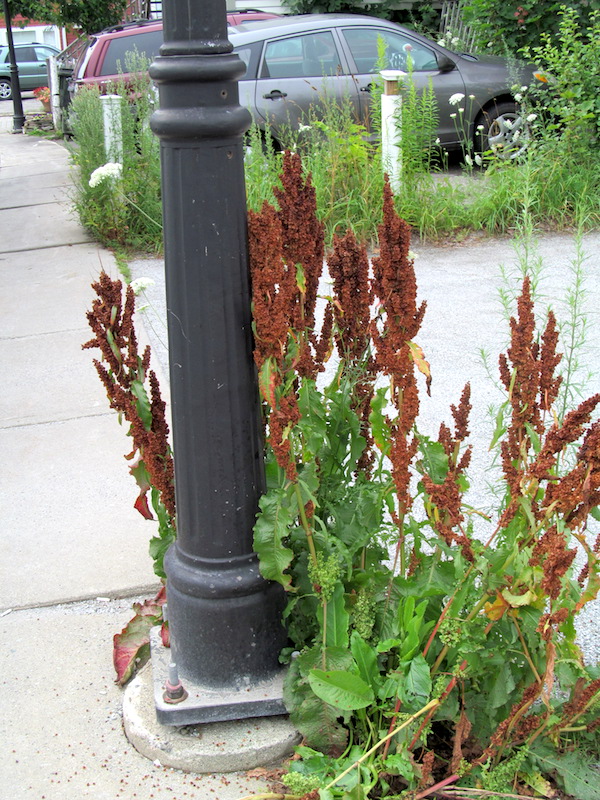
Choose Sweet and Tender Edibles
For the most part, everyone gets excited about foraging in the spring as the new growth bursts from the earth anew. The problem is, most spring greens are bitter and not exciting to young palates.
Don’t try to force it! Once a kid learns that foraging is just an excuse to shove bitter dandelion greens at them they’re not going to be excited about the adventure.
Just as you’re expanding their horizons, you need to expand yours as well so that you’re guiding them towards sweet, tender, and kid-friendly edibles.
Linden buds are some of the sweetest greens around, and they bring a smile to my little one’s face with ease. While dandelion greens might not be a good choice, the flowers themselves are tasty if you use them to flavor kid-friendly treats like dandelion ice cream.

Forage for Known Foods (like Berries)
When kids learn that the woods can be their grocery store, providing foods they’re familiar with already, that’s almost more exciting than learning to identify strange wild weeds. Edible wild berries are some of the absolute best choices when foraging with kids. Many are incredibly easy to identify, like wild raspberries.
When I led my 18-month-old son over near the raspberry patch, I didn’t have to tell him twice. He knew his favorite food when he saw it, and after I picked one off and put it in his hand it was like his whole world expanded right before my eyes.
To see the look on his face, you’d have thought I showed him an ice cream bush, not a wild raspberry. I can only imagine his thinking, realizing that raspberries just grow right out there for the taking. Simple things we take for granted are really magical when the whole world is new.
Once they know you’re showing them good stuff, kids are more liable to trust you when you try to introduce them to new exciting wild edibles.
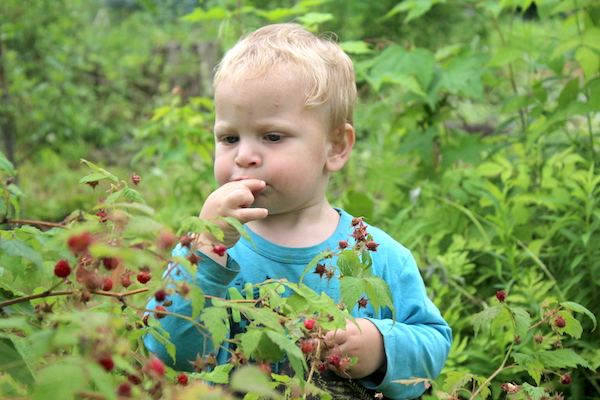
Make Fun Foraged Treats
Beyond just tasting wild edibles in the field, the adventure can continue into the kitchen with kid-friendly edibles. Last spring we baked a Japanese knotweed pie, and the little ones couldn’t taste the difference between it and the rhubarb pies from the week before. Similarly, wild hawthorn lollypops were a huge hit.
While sweets are an obvious choice, you don’t have to pack on the sugar to make things kid-friendly. Think warm, savory comfort foods. Dice up some wild ramps into homemade mac and cheese, or make a warm and creamy chanterelle risotto.
Still, when all else fails, make ice cream out of it.
Really, you can make ice cream out of almost anything. We made chanterelle ice cream this summer, and months later when you ask my daughter what her favorite ice cream flavor is she’ll sill enthusiastically answer “Mushroom Ice Cream!”
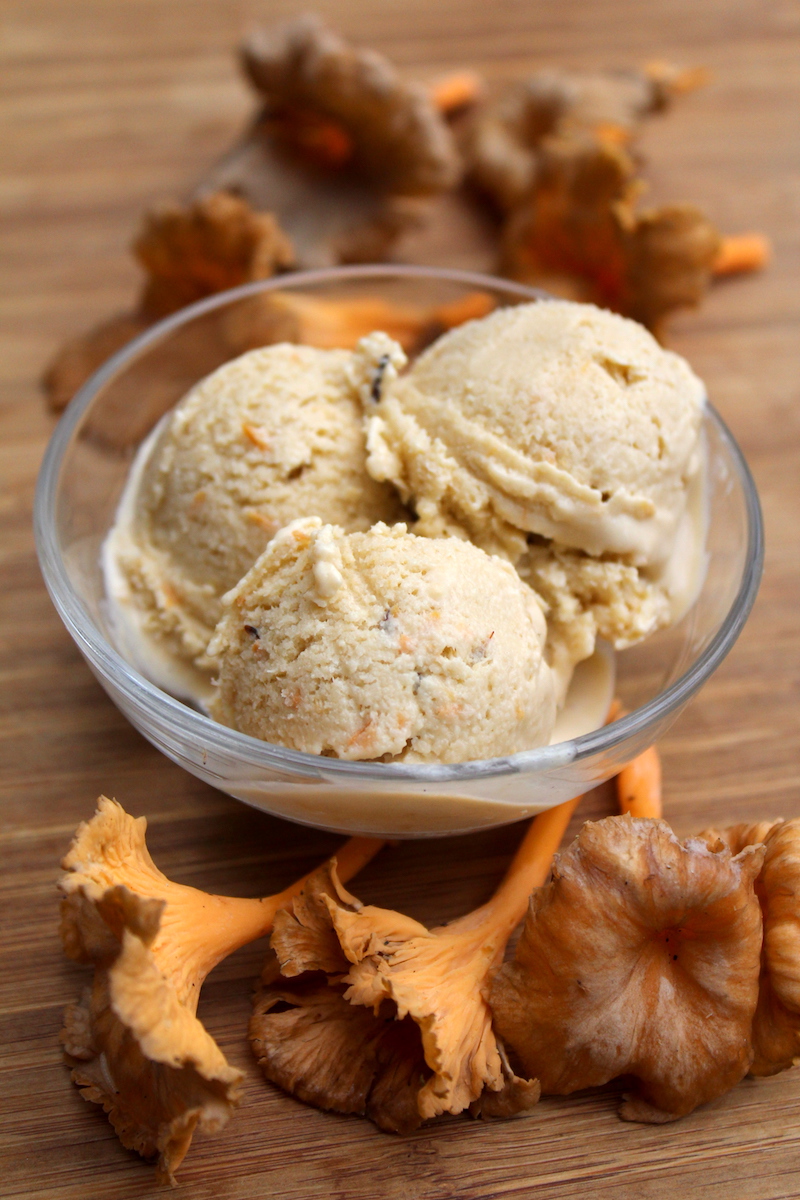
Don’t Under Estimate Their Taste Buds
I know, all I’ve been talking about thus far is making sure foraged foods are sweet, tender and kid-friendly.
That’s true… to a point.
Don’t let your adult bias keep you from sharing some more exotic flavors with your little ones. I try to use a bit of Huck Finn psychology whenever I can. While I’m not convincing them that panting a fence is the best thing ever, I am leading by example trying new things.
I made a big show of how tasty dandelion coffee is, and my little one couldn’t wait to try it.
It tastes an awful lot like coffee, bitterness included, but she drank her whole cup. Maybe it was the fact that she could have her own caffeine-free cup and share coffee time with mama, or maybe it was the excitement that she harvested, cleaned, and processed the roots herself…but the bitterness was no obstacle.
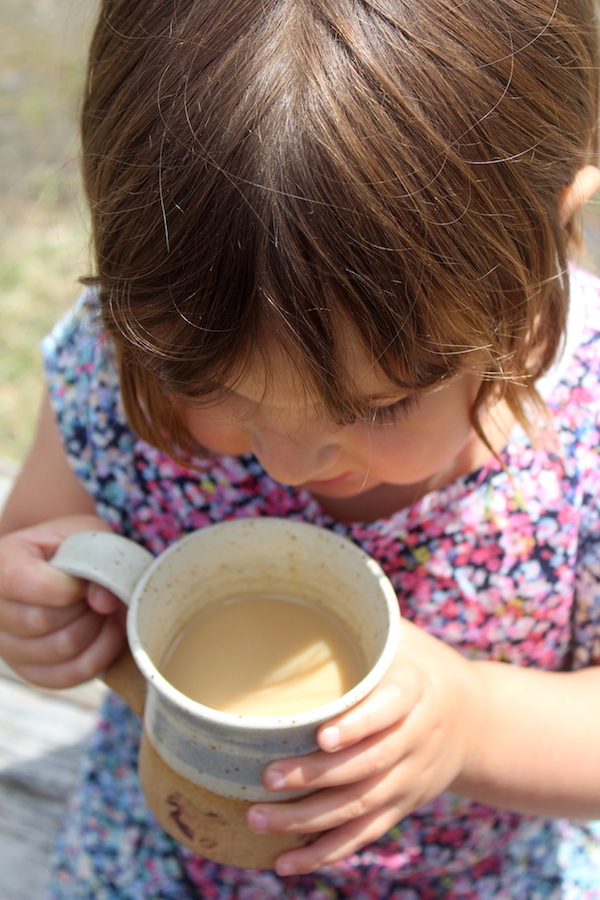
Forage in Kid Friendly Locations
The adventurer in me wants to stop the car every time I see a patch of something tasty and exciting, but that’s just not an option with little ones.
I passed up a patch of wild asparagus because a narrow strip between railroad tracks and the highway is just not a good foraging spot period, let alone with kids. Alone, I’ll admit I’d be all over crawling down a ravine or foraging in other semi-hazardous locations.
I really rein in that impulse now that I’m foraging with kids.
More often than not, if we’re going to go out somewhere to forage I choose somewhere that’s stroller friendly. That allows for snack storage and is a bonus carrier in case we find a big patch of something exciting.
An old rail trail near our home is the perfect spot, and last summer we found all manner of wild berries, cattails, wild ginger, tinder polyspore mushrooms, and several dozen species of wild weeds.
You don’t have to go too far off the beaten path if you keep your eyes open…
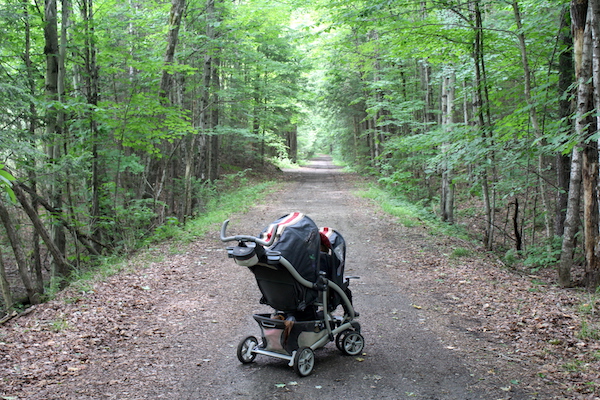
Look for Year-Round Foraging Options
You don’t have to tell me that pickings are slim in the wintertime.
Up here in Vermont, proper winter lasts about 5 months, with a crisp fall beforehand and at least a month of mud and stick season after. That said, if we limited our foraging to just the bright summer days, it’d be a very small part of our lives simply because so much of the year the world is covered in snow.
If you’re creative and really learn to watch the landscape, there’s quite a bit to harvest even in the dead of winter. Here’s a list of more than 50 things we’ve found to forage in winter, in a climate where temps dip to -25 part of the year.
One of the easiest to find, and most accessible options are rose hips which generally hold on the bushes all through winter. Staghorn sumac is another good choice, and it can be made into a lemonade-like drink (even in January).
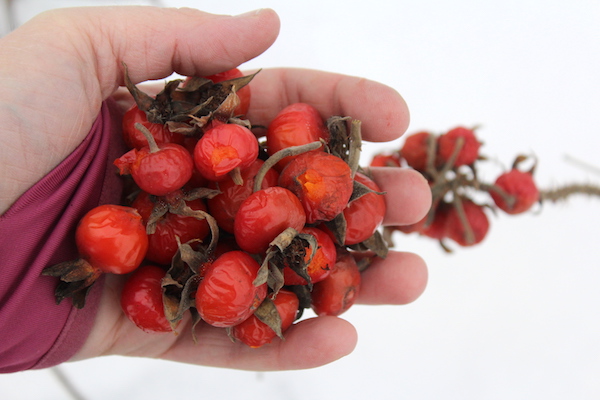
Lastly, in the winter and early spring, don’t forget about syrup!
There are nearly 30 trees that can be tapped for syrup, including maple, birch, ironwood, linden, and many more. Even if you don’t have maples nearby, there’s likely a way to make syrup where you are.
Only Forage Plants You’re 100% Sure You Can Identify
While this should go without saying, whether you’re foraging with kids or not, only eat plants you can positively identify.
If you’re not sure about something, say so. Kids need to know that even parents are cautious when it comes to identifying plants, and I’ll make a big show of collecting something that we can all go research when we get home.
We’ll sit down with the identification books together and go over the features of a particular plant piece by piece. It’s a good exercise for everyone, adults and kids alike.
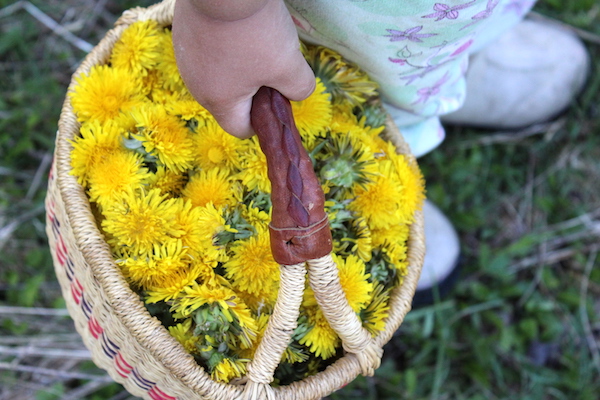
Don’t Forget to Have Fun
I know this one maybe seems obvious when working with kids, but I’ll be honest that I struggle with it. I get focused on searching for a particular plant, or harvesting enough of something to make something really special…and I forget to make time for the simple joys.
A hat made out of moss from the forest floor or a game of tick tack toe on the back of a shirt using the sticky velcro from beechnut pods…really anything to bring play into the activity.
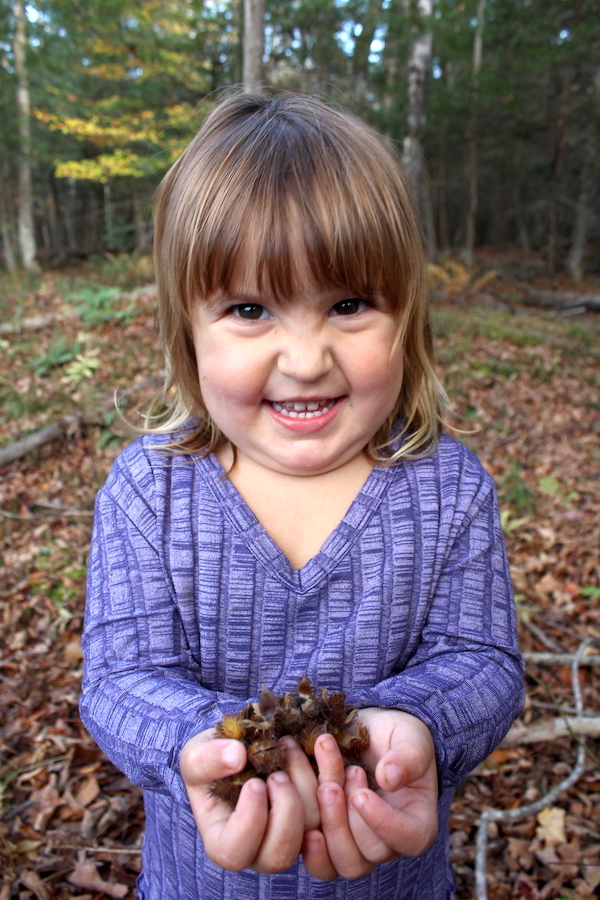
Kids are generally really good at finding the play in just about any activity, but that challenge as an adult is making that space for fun. Allowing for extra lingering when needed and remembering that making memories is just as important, if not more important, than harvesting dinner.
Foraging with kids can be a fun activity for everyone, and seeing the wonder in a child’s eyes when they learn a new plant renews my sense of wonder as an adult.
Resources for Foraging with Kids
If you’re a beginning forager and excited to get into it with the whole family, I’d highly recommend any foraging books by Samuel Thayer. He began foraging very young, and many of the stories in his books are told through a child’s eyes, discovering a wild plant for the very first time.
The book Foraging With Kids is also another great choice…
We have a board game that’s targeted at the age group 4+ that’s also a fun way to stay engaged with plants and foraging in the winter. It’s called Wildcraft, and the illustrations and simple gameplay are just right for kids 4 to 12.
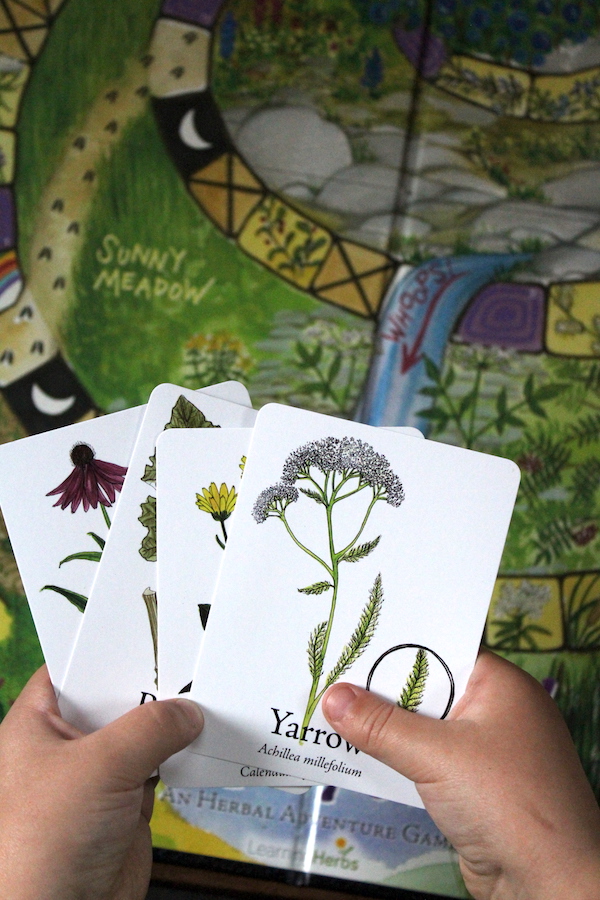
I’ve also found this online Botany and Wildcrafting Course by the Herbal Academy to be a great resource, and I’ve spent time working through it with my daughter on my lap.
The text is definitely written for adults, but the course material is vividly photographed to engage just about anyone. I’d read through it, while she was mesmerized by the pictures, and then go back and translate it to her level.
That said, when I was in junior high and high school I would have died for the chance to take this course, so it might be a good fit for older kids. For grade school kids, they also have a free course called introduction to herbs for kids that’s filled with games and worksheets targeted at early readers through middle school. It’s herbally focused, but there’s a good bit of foraging content in there too.
I just recently learned about a free online magazine called Wild Kids: Seasonal Nature Education for Kids and their Grown Ups. It’s full of all manner of outdoor education, with a heavy focus on foraging! I just subscribed, and I’m my little ones were really excited about not only the foraging pieces but the detailed wildlife tracking info too.
Anything to get them outside right in the thick of nature…
What have you foraged with your little ones? How was the experience? Leave me a note in the comments.
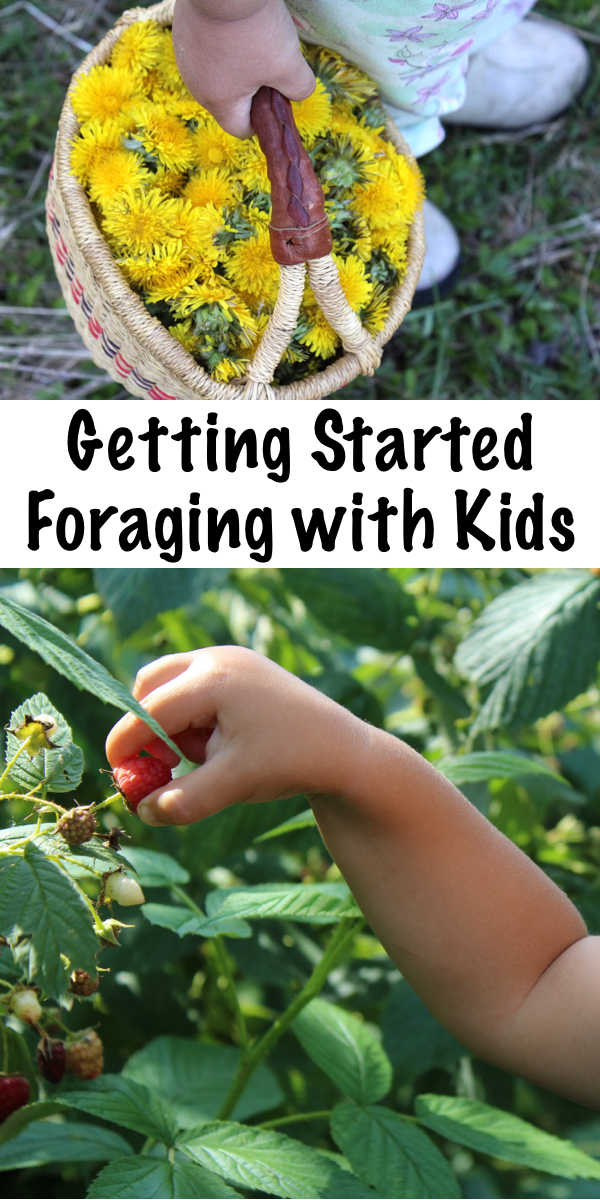


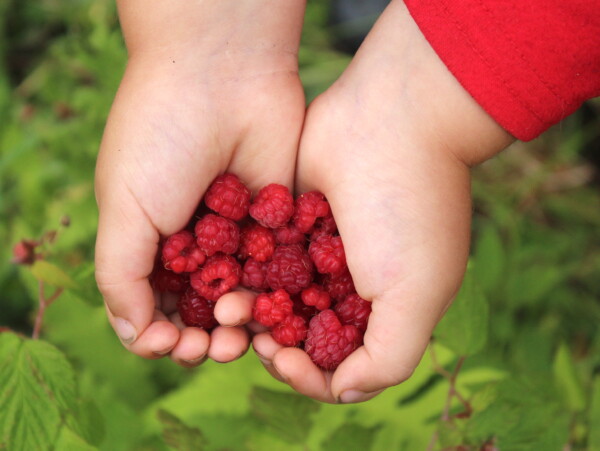
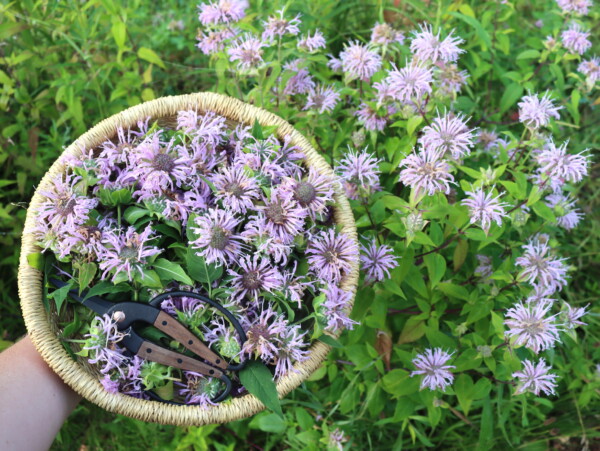
Great article and photos! Like you, I find that very small kids take to foraging quickly and safely with a little guidance. Here’s my toddler grazing in the back yard, learning to forage with that ease and enthusiasm peculiar to very small people!
Thank you so much for this article! I have been wanting to forage for a long time since I originally came form Europe and most people forage there, at least for mushrooms and wild blueberries and strawberries. I get a bit overwhelmed here in the states because I don’t know how to find land to forage without trespassing.
My kids and I have done some foraging in urban setting. A few times we picked delicious juneberries planted as ornamental at an outdoor mall. We also picked white mulberries while walking to laundromat when we lived in the city. I definitely want to teach my kids to forage so hopefully I get more adventurous. Any advice how to find places to forage without getting on someone’s private property?
Thank you!
Gerda
Believe it or not, most state and national parks are open to foraging (check locally to be sure). In public parks and arround commercial bildings likewise are usually fair game, unless they say otherwise. Though in those locations you need to be especially careful because they’re sometimes sprayed.
Here in Vermont you’re allowed to go anywhere you want, unless the land is explicitly “posted.” Clearly you shouldn’t actually pick stuff out of people’s gardens or front lawns, but there are a lot of places “in between” where things like wild blackberries grow. Power way stations with fences around them covered by wild grapes. Weeds abound everywhere. I’m sure you’ll find places, even if they’re just growing through the cracks in the sidewalk.
Have fun finding the good spots with your little ones!
We’ve been foraging as a family for about 15 years now and it’s such a blessing for our family. Wild foods are tasty, healthy, nutritious and free, and foraging gets us all out in nature together. I put out a free nature magazine for kids (and their grown ups) where my kids and I share foraging information and other nature fun if anybody would like to learn more about foraging with kids. There are also coloring pages, nature poems and other seasonal nature goodness. You can read it or print it here (nothing to sign up for or buy, just free for anyone who can use it): http://magicalchildhood.com/wildkids/
Oh my goodness, I just checked out your latest edition and I love it! I just subscribed, and I can’t wait for next month =) Really beautiful work. I’m adding a link to this into the article now.